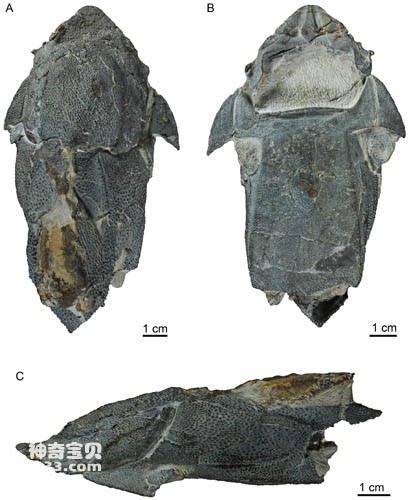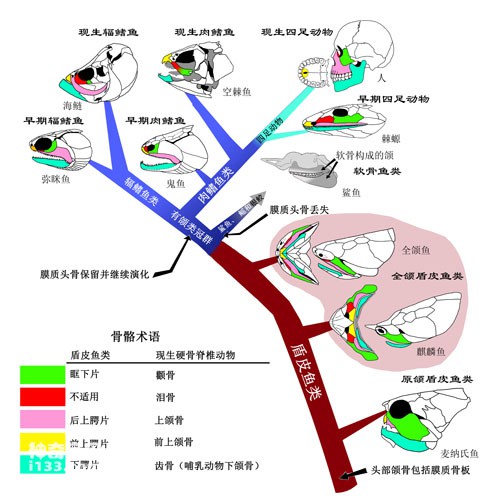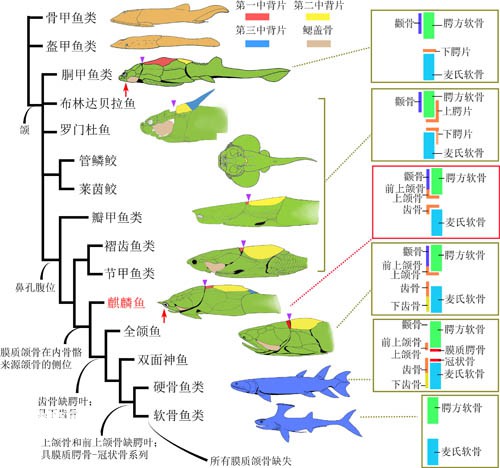The joint team of Zhu Min from the Institute of Vertebrate Paleontology and Paleoanthropology of the Chinese Academy of Sciences and Ahlberg of Uppsala University in Sweden has made a major breakthrough in the field of research on the evolution of vertebrate jaws. They reported in the latest issue (October 21, 2016) of the magazine Science that a 423-million-year-old Silurian placoderm fish, Qilinyu rostrate, was filled with hard bones The morphological gap between the fish-like holognathus and the placoderm protognathus was proposed for the first time in the world. The theory that the jaw bone plates of the placoderms are homologous traces the human jaw all the way back to the most primitive jawed vertebrates, the protognathed placoderms.
This key breakthrough "clears a big blind spot in our understanding of the evolution of vertebrate jaws", "Science" magazine specially distributed it in the Perspective column of the same period. A review article titled "First jaws" by Professor John Lang, President of the Society of Vertebrate Paleontology and Professor of Flinders University, Australia. The review stated that a series of discoveries from China "are changing the understanding that placoderms are extinct, and placoderms have become the key to understanding how the body structure of vertebrates evolved step by step in the long past."
The armored ruler of the age of fish
The Devonian Period (approximately 419 to 359 million years ago) is known as the "Age of Fishes." At that time, aquatic vertebrates, especially jawed vertebrates with upper and lower jaws, evolved explosively. All kinds of fish crowded the waters of the earth. The dominant ones were those whose bodies were covered with large bone plates. The placoderms, regardless of the number of species, the number of individuals or the diversity of forms, are the undisputed rulers of the fish era. By the late Devonian period, they had evolved into one of the most famous prehistoric super predators—— Dunkleosteus. The body length of Dunkleosteus can reach 10 meters. Its upper and lower jaws are armed with sharp blade-like bone plates and have a powerful bite force like hydraulic shears. It feeds on various large fish in the waters where it lives.
However, as the age of fish came to an end, Dunkleosteus and other placoderms suddenly became extinct at the end of the Devonian Period 359 million years ago. The living space they left was occupied by more advanced bony fish and cartilaginous fish. Class carve up. Cartilaginous fish include today's sharks, rays and chimaeras, while bony fish split into two and evolved into ray-finned fish and lobe-finned fish. They became the conquerors of the earth's waters and land respectively today. There are about 25,000 species of finned fish, including most of the various fish species today. Although lobe-finned fish declined in the water, one of them landed on land and gave rise to all species, including humans. of terrestrial vertebrates.
For many years, paleontologists have tried to figure out the evolutionary relationships between these groups, and then sort out the genealogy of human ancestors. How did we evolve from those long-dead, bizarre, fish-shaped ancestors? In the past, early fish fossils were mostly found in the Devonian strata. At that time, the major groups had already differentiated, and there was a lack of transitional fossils in the intermediate state; before the age of fish, tracing back to the more distant Silurian Period, the evolution of vertebrates History has been lost to oblivion. For a long time, scientists have only been able to restore this period of history through scraps of fragmentary materials, like a blind man touching an elephant. Finding fully preserved ancient fish in the Silurian strata is the "Holy Grail" coveted by paleontologists around the world.
The lost ancient fish kingdom of the Silurian
From the Silurian to the Devonian, southern China was an isolated island drifting near the equator. Yunnan is located in the southern part of the continent. The river meandered out from the exposed barren mountains in the center of the continent (plants had not yet invaded the interior at that time), and merged into the ocean at a place equivalent to modern Qujing in eastern Yunnan, bringing rich nutrients and nurturing a thriving ecology in the estuary and bay. System, here is the "kingdom" of fish: crinoids and brachiopods thrive near the reefs, providing hiding places for fish; groups of small fish work hard to filter sediment at the bottom of the water, or look for worms, etc. Soft food; ferocious large predatory fish cruised above their heads... Over tens of millions of years, how many bizarre fish have lived, reproduced, and died here. Their bodies sank to the bottom of the water and were wrapped in sand. A few were lucky. The earth formed fossils.
More than 400 million years have passed, the sea and the land have changed, and the ancient bay has long turned into the rolling hills and fields in eastern Yunnan today. Ancient seabed sediments formed layers upon layers of strata through long and complex geological processes. Continuous sedimentation across the Silurian and Devonian periods is exposed here. In these thousands of geological books, precious information about the evolution of life is preserved, which has never been known before.
As early as the last century, Chinese scientists found a variety of peculiar primitive bony fishes in the Early Devonian strata in eastern Yunnan. However, by this time the age of fishes had entered its heyday, and the major groups had long gone their separate ways. These discoveries can only provide some indirect hints for studying the genealogy of human aquatic ancestors. Could the "holy grail" of ancient fish research be found in the earlier Silurian strata? After decades of unremitting search, Zhu Min's team finally found a beautifully preserved fish fossil in the Silurian strata near the Xiaoxiang Reservoir in Qilin District, Qujing, Yunnan in 2007. This is a unique and completely preserved fish fossil in the world. Jaw vertebrate fossils of the Xiaoxiang fauna. The lost "kingdom" of ancient fish from the Silurian Period has been rediscovered.
However, the diversity of the Xiaoxiang fauna far exceeds Zhu Min and others’ initial expectations. After several years of continuous excavation, they discovered that this ancient fish “kingdom” once flourished, and the fossils that have been discovered alone may represent about 20 to 30 years of age. A whole new kind of fish. These ancient fish are not only very old, but also very strange in shape. Similar species cannot even be found in other parts of the world. They belong to some brand-new groups that have never entered the field of science.
Placoderms are the main components of the Xiaoxiang fauna. However, most of the placoderms here belong to a unique and previously unknown lineage. This lineage only existed in southern China in the late Silurian period. Then it mysteriously disappeared into the long river of life evolution. Zhu Min and others named it "holognathic placoderm fish". The front half of their bodies is covered with large bone armor. Their shape is not far from that of other placoderm fish, but the jaw bones are typical bony fish patterns. , that is, the "whole jaw" composed of a series of complex bone fragments. This kind of placoderm fish with bony fish jaws, just like the feathered dinosaurs confirming the origin of birds, clearly shows that bony fishes evolved directly from placoderm fish, completely overturning the past. Understanding of the evolutionary relationships among major groups in the age of fish.
In 2013, Zhu Min and others reported the first member of the holognathous placoderms, Holognathus, in the British magazine Nature, which immediately attracted widespread attention. Holognathus has been called "a jaw-dropping fish" and hailed as "one of the most important fossil discoveries of the past century." But soon, more holognathic placoderm fossils were discovered. It seems that this group was also "separated". Although its survival time and range were very limited, it was once very prosperous and occupied a variety of ecological niches. The newly reported long-snouted Kirinfish not only has characteristics that can unambiguously classify it as a holognathus placoderm, but its appearance is also very different from the original holognathus that has been discovered in many places, which fully reflects the holognathus. Diversity of skin fish.
The name of the unicorn fish is a pun. It is not only named after the Qilin District of Qujing City where it was discovered, but also implies that it is like the legendary mythical beast unicorn with a dragon head, antlers, an elk body, and an ox tail. It combines the characteristics of multiple taxa. The fossils of the unicorn fish are very exquisite. The large bone armor that wraps its body has perfectly preserved its shape after more than 420 million years. Its head is both a bit like a dolphin and a bit like a sturgeon. It has a forward flat snout at the front, followed by a raised "forehead", and the mouth and nostrils are located on the ventral surface. Its body is long and box-shaped with a flat bottom. In the bay of Qujing in the Silurian period, they probably gathered in groups, swimming slowly on the bottom of the water, turning up the sand with their snout, looking for worms and organic debris to feed on, and relying on their bone armor and protective coloration to resist predators.
The unicorn fish is small, about 20 centimeters long when alive, and its appearance is not very eye-catching. However, Zhu Min and others found that its jaw shape rarely preserved the intermediate stage of evolution, providing key clues to an important question that had not been answered before in holognathus, that is: the jaws and placoderms of teleost fishes Are fish jaws homologous? If so, how did the former evolve from the latter?
The evolution of jaws from fish to humans
The mouth with upper and lower jaws is an important organ for humans to eat, breathe, and communicate. It is also a common feature of all jawed vertebrates from fish to humans. The structure of the human upper and lower jaws does not seem to be complicated, but in fact, they have gone through a tortuous and complicated evolutionary process before they finally became what they are today.
The upper and lower jaws evolved from the gill arches and were first composed of cartilage in the body. During the long evolutionary process, bone fragments (membranous bone) from the body surface gradually invaded the upper and lower jaws, reinforcing and replacing the function of the original jaws. It was the addition of these later jaws that gave rise to complex oral structures such as teleost fish's mouths that can extend to suck in food, beaks of various shapes, and Elephants-Are-Endangered.html">elephants' giant teeth and tusks, which eventually formed the Human jaws, and the original jaw components derived from cartilage have long retreated into the ears and become ossicles, forming part of the auditory system.
The human jaw can be traced relatively clearly all the way back to our primitive bony fish ancestors. Three major pairs of jaws, including the premaxilla (the only remaining survivor in humans), the maxilla, and the dentary, are located at the edge of the mouth, adjacent to the other bones of the face. In primitive bony fish, there are also a series of jaws inside these marginal jaws such as vomer, pterygoid, and coronal bones. They once had the function of biting, but after long-term evolution, they have disappeared or retreated into the nasopharyngeal cavity in humans. . We refer to the more complex jaws of bony fishes, which are composed of many bone fragments, as the "whole jaw state".
So, how did the full jaw state evolve? Since this pattern of jaws has not been found in large groups other than bony fishes, there has been no definite answer to this question. The jaws of cartilaginous fish are entirely composed of cartilage without any reinforcement of membranous bone; while the jaws of typical placoderms like Dunkleosteus are called "protognathic state", although there are already sources of membranous bone. There are three pairs of bone plates: the anterior upper palate, the posterior upper palate, and the lower palate, but they are all located on the inside of the mouth and are not connected to other bones of the face.
The primitive holognathus has conclusively demonstrated that bony fishes evolved from a branch of placoderms. So, are there evolutionary connections between the three pairs of jaw bone plates of placoderms and the jaws of bony fishes? Judging from their position, these three pairs of bone plates should be equivalent to the medial jaws of bony fishes, but the number of the latter is far more than three pairs. Therefore, the previously proposed theory of the origin of the full jaw believes that the three pairs of medial jaw bones of placoderms were lost during the evolution from placoderms to bony fishes. All jaws in the full jaw state, including the lateral and medial series, They are all re-evolved.
Obviously, this theory requires considerable changes and reorganization of the jaws, and in most cases evolution tends to be more patchy and conservative. In contrast, the second possible theory is more straightforward: the three pairs of inner jaw bones of placoderms moved outward and became the outer three pairs of marginal jaws in the full-jawed state. Teleosts are just a new evolution. Out of the medial series of jaws.
Holognathus has evolved a nearly complete set of bony fish-style holognath jaws, which are completely different from the jaws of other placoderms, leaving an obvious evolutionary gap. To choose between the above theories and answer the question of where the holognathic state came from, a more primitive jaw than holognathic fish is needed.
Incomplete full jaw
From many aspects, the shape of Kirin fish is more primitive than that of holognathus. Can it answer the question about the recovery of holognathus?What about the questions you can’t answer? Zhu Min and others conducted high-precision CT scans of the Qilin fish fossils, and carefully reconstructed the bones piece by piece into a three-dimensional model in the computer. After repeated comparative studies, they found that Kirinfish, like the holognathus, already has an upper jaw composed of a maxilla and a premaxilla. However, Kirinfish has not yet evolved the series of bone fragments that cover the bottom of the lower jaw that both holognathus and bony fish have. Its lower jaw only has a simple mandible, and this mandible still retains the obvious curling into the mouth. Unlike holognathus and later bony fish, only a narrow biting surface remains in the mouth. The jaw shape of Kirinfish is indeed in a state between holognathus and other more primitive placoderm fishes. It has an "incomplete holognath".
This "incomplete full jaw" shows an intermediate state in the early evolution of the jaw: the jaw of the unicorn fish has bid farewell to the original model of the placoderm fish and entered a new stage of evolution. The membranous bone fragments began to extend outside the mouth. Covers and strengthens the jaws, but does not yet reach the level of perfection of a full-jawed fish. This further reveals the evolution process of the holojaw pattern, supports the second theory mentioned above about how the holojaw pattern evolved, and establishes the maxillary, premaxillary and dentary bones of teleosts and the three pairs of jaws of placoderms. The homologous relationship of the bone plates. Human jaws can be traced back not only to bony fishes and holognathids, but also to our more ancient ancestors, the protognathous placoderms.
Throughout the entire history of life evolution, major evolutionary events are often leap-forward and fleeting on the geological time scale, making them difficult to preserve in fossil records, resulting in a large number of morphological gaps and evolutionary gaps among biological species. The longer the time goes by, the more and more these gaps and missing links will become. Occasionally, we are lucky enough to find some transitional fossils that fill these gaps and missing links. They open up rare windows and allow humans to have a glimpse of the mysteries of evolution. As more discoveries emerge from the lost ancient fish kingdom of Silurian Yunnan, there are still more fragments of the evolutionary epic to be completed.
This achievement was funded by the National Ministry of Science and Technology’s 973 Project, the National Natural Science Foundation of China’s Key Project, and the Chinese Academy of Sciences’ Frontier Science Key Research Project. The field excavation was supported by governments at all levels in Qujing City, Yunnan Province.

Figure 1 Photos of the holotype specimen of Unicornus longnose (IVPP V20732), dorsal view (A), ventral view (B), lateral view (C) (Photo provided by Zhu Min)

Figure 2 Ecological restoration map, unicorn fish swimming in the Silurian ancient ocean 423 million years ago (drawn by Yang Dinghua)

Figure 3 The evolution of vertebrate membranous jaws (illustrated by Brian Choo)

Figure 4 A simplified phylogenetic tree showing the evolutionary sequence of membranous jaws from the placoderm protognathic pattern to the teleost holognathic pattern. The brown body silhouette represents the jawless gnathostome group (armored fishes), the green body silhouette represents the jawed gnathostome group (placoderms), and the blue body silhouette represents the jawed crown group. . The red arrow indicates the location of the mouth, and the brown arrow indicates the boundary between the head and carapace. (Photo provided by Zhu Min)
animal tags:
We created this article in conjunction with AI technology, then made sure it was fact-checked and edited by a Animals Top editor.